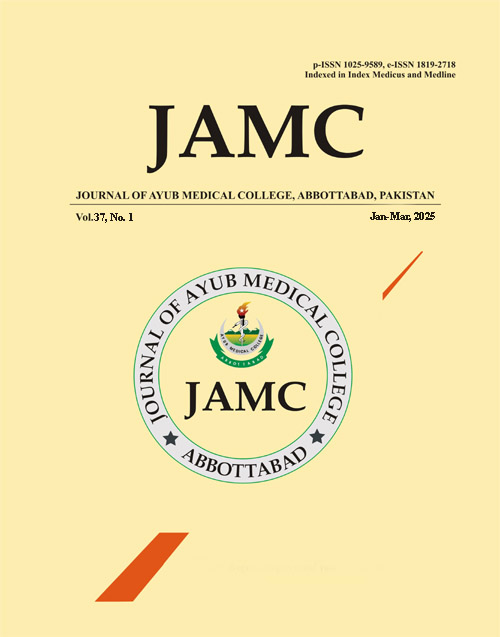THE EFFICACY OF TVS IN MEASURING CERVICAL PARAMETERS COMPARED TO THE BISHOP SCORE FOR PREDICTING LABOR INDUCTION OUTCOMES
DOI:
https://doi.org/10.55519/JAMC-01-14271Keywords:
Labour Induction; Transvaginal Ultrasonography; Bishop Score; Cervical Assessment; Pregnancy; ObstetricsAbstract
Background: Labor induction requires accurate assessment of cervical readiness. The Bishop score is commonly used but is subjective and variable. Transvaginal ultrasonography (TVS) offers a more standardized approach. This study compares TVS and the Bishop score in predicting labor induction outcomes. Objective was to evaluate the efficacy of TVS in measuring cervical parameters compared to the Bishop score for predicting labor induction outcomes. Methods: This is a descriptive cross-sectional study conducted at Pakistan Air Force Hospital, Kamra and Pakistan Air Force Hospital, Islamabad from December 2023 till May 2024. Pregnant patients with cephalic singleton pregnancies were included. TVS and Bishop scores were recorded, and labor induction was initiated based on these scores. Data were analyzed using SPSS. Results: Of 100 participants, most were between 19 and 32 years old (mean age 21.23 years) and more than 39 weeks pregnant. Induction success rate was 81%. TVS scores above 4 correlated with successful inductions (93.2% success rate), while lower scores had a higher failure rate (93.24% sensitivity, 73.08% specificity). Conclusion: TVS is more accurate than the Bishop score in predicting labor induction outcomes. Its wider adoption could improve the success of labor induction and reduce complications.
References
1. Baron YM, Schembri M. Induction of Labour. In: Mahmood T, Ventura CS, Messinis I, Mukhopadhyay S, editors. The EBCOG Postgraduate Textbook of Obstetrics & Gynaecology: Obstetrics & Maternal-Foetal Medicine. Cambridge: Cambridge University Press; 2021. p. 381–8. (Cambridge Medicine; vol. 1).
2. Agrawal A, Tripathi PS, Bhandari G, Kheti P, Madhpuriya G, Rathore R. Comparative study of TVS cervical score and Bishop score in prediction of successful labour induction. Egypt J Radiol Nucl Med 2022;53(1):138.
3. Strobel E, Sladkevicius P, Rovas L, De Smet F, Karlsson ED, Valentin L. Bishop score and ultrasound assessment of the cervix for prediction of time to onset of labour and time to delivery in prolonged pregnancy. Ultrasound Obstet Gynecol 2006;28(3):298–305.
4. Bajpai N, Bhakta R, Kumar P, Rai L, Hebbar S. Manipal cervical scoring system by transvaginal ultrasound in predicting successful labour induction. J Clin Diagn Res 2015;9(5):QC04.
5. Tsakiridis I, Mamopoulos A, Athanasiadis A, Dagklis T. Comparison of transabdominal and transvaginal ultrasonography for the assessment of cervical length in the third trimester of pregnancy. Taiwan J Obstet Gynecol 2019;58(6):784–7.
6. Kim Y, Kwon JY, Kim EH. Predicting labour induction success by cervical funneling in uncomplicated pregnancies. J Obstet Gynaecol Res 2020;46(7):1077–83.
7. Wiafe YA, Whitehead B, Venables H, Nakua EK. The effectiveness of intrapartum ultrasonography in assessing cervical dilatation, head station and position: a systematic review and meta-analysis. Ultrasound 2016;24(4):222–32.
8. Bastani P, Hamdi K, Abasalizadeh F, Pourmousa P, Ghatrehsamani F. Transvaginal ultrasonography compared with Bishop score for predicting cesarean section after induction of labour. Int J Womens Health 2011;3:277–80.
9. Pandis G, Papageorghiou A, Ramanathan V, Thompson M, Nicolaides K. Preinduction sonographic measurement of cervical length in the prediction of successful induction of labour. Ultrasound Obstet Gynecol 2001;18(6):623–8.
10. Tan P, Vallikkannu N, Suguna S, Quek K, Hassan J. Transvaginal sonography of cervical length and Bishop score as predictors of successful induction of term labour: the effect of parity. Clin Exp Obstet Gynecol 2009;36(1):35–9.
11. Raynelda F, Lukas E, Qadar S, Chalid MT. Comparison of Bishop score and cervical length measurement through transvaginal ultrasound as prediction against labour induction. Asian Pac J Reprod 2018;7(6):280–4.
12. Ivars J, Garabedian C, Devos P, Therby D, Carlier S, Deruelle P, et al. Simplified Bishop score including parity predicts successful induction of labour. Eur J Obstet Gynecol Reprod Biol 2016;203:309–14.
13. Boozarjomehri F, Timor-Tritsch I, Chao CR, Fox HE. Transvaginal ultrasonographic evaluation of the cervix before labour: presence of cervical wedging is associated with shorter duration of induced labour. Am J Obstet Gynecol 1994;171(4):1081–7.
Downloads
Published
How to Cite
Issue
Section
License
Copyright (c) 2025 Ghana Shahid, Shehnaz Sheeba, Adeela Anwar, Amina Akbar, Sadaf Afroze, Shakra Tabasam

This work is licensed under a Creative Commons Attribution-NoDerivatives 4.0 International License.
Journal of Ayub Medical College, Abbottabad is an OPEN ACCESS JOURNAL which means that all content is FREELY available without charge to all users whether registered with the journal or not. The work published by J Ayub Med Coll Abbottabad is licensed and distributed under the creative commons License CC BY ND Attribution-NoDerivs. Material printed in this journal is OPEN to access, and are FREE for use in academic and research work with proper citation. J Ayub Med Coll Abbottabad accepts only original material for publication with the understanding that except for abstracts, no part of the data has been published or will be submitted for publication elsewhere before appearing in J Ayub Med Coll Abbottabad. The Editorial Board of J Ayub Med Coll Abbottabad makes every effort to ensure the accuracy and authenticity of material printed in J Ayub Med Coll Abbottabad. However, conclusions and statements expressed are views of the authors and do not reflect the opinion/policy of J Ayub Med Coll Abbottabad or the Editorial Board.
USERS are allowed to read, download, copy, distribute, print, search, or link to the full texts of the articles, or use them for any other lawful purpose, without asking prior permission from the publisher or the author. This is in accordance with the BOAI definition of open access.
AUTHORS retain the rights of free downloading/unlimited e-print of full text and sharing/disseminating the article without any restriction, by any means including twitter, scholarly collaboration networks such as ResearchGate, Academia.eu, and social media sites such as Twitter, LinkedIn, Google Scholar and any other professional or academic networking site.










